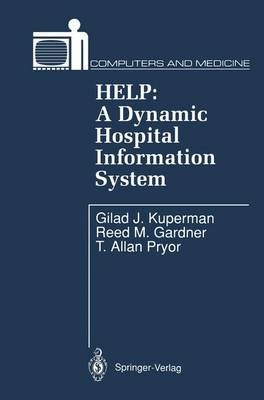
HELP
Springer-Verlag New York Inc.
978-0-387-97431-6 (ISBN)
- Titel ist leider vergriffen;
keine Neuauflage - Artikel merken
I. Overview of the HELP System.- 1. History of the HELP System.- 1.1 The Cardiovascular Period: 1954 to 1967.- 1.2 Expansion of the Database: 1967 to 1972.- 1.3 Growth of Clinical Applications/Addition of Decision-Making Capability: 1972 to 1990.- 1.4 Conclusion: The HELP System Today.- References 13.- 2. HELP System Hardware.- 2.1 Tandem Computer.- 2.2 Other Computer Systems Connected to the Tandem.- 2.3 Summary.- 3. The Data Dictionary and Data and File Structures.- 3.1 Medical Terminology Representation Scheme.- 3.2 HELP System Data Structures.- 3.3 HELP System File Structures.- 3.4 Database Query Languages.- 3.5 Summary.- 4. HELP System Interfaces.- 4.1 Data Acquisition.- 4.2 Outputs.- 4.3 Conclusions.- References.- 5. Decision Support on the HELP System.- 5.1 Data, Information, and Knowledge.- 5.2 Data Management on the HELP System.- 5.3 Information Processing on the HELP System.- 5.4 Use of Computerized Medical Knowledge on the HELP System.- 5.5 Summary.- References.- 6. Current Usage of the HELP System.- 6.1 Evaluation of the HELP System.- 6.2 User Attitudes.- 6.3 Security.- 6.4 Future Directions of the HELP System.- 6.5 Summary.- II. Administrative Functions on the HELP System.- 7. Admit-Discharge-Transfer Functions.- 7.1 Patient Types and the Master Patient Index.- 7.2 Scheduling and Admitting Programs.- 7.3 Patient Numbers.- 7.4 Transfers and Discharges.- 7.5 Room Trace and Census.- 8. Medical Records Functions.- 8.1 Overview.- 8.2 Medical Records Data Maintained on the HELP System.- 8.3 Manipulation of the Medical Record.- 8.4 Chart Location.- 8.5 Reports and Other Utilities.- Reference.- 9. Computerized Data in Quality Assurance.- 9.1 Overview.- 9.2 Quality Assurance.- 9.3 Blood Ordering Program.- 9.4 Pharmacy.- 9.5 Infectious Disease Monitoring.- 9.6 Pathology.- 9.7 Nutritional Support.- 9.8 Respiratory Therapy.- 9.9 Computerized Laboratory Alerting System.- 9.10 Other Functions.- 9.11 Continuous Quality Improvement.- References.- 10. Surgery Scheduling.- 10.1 Overview.- 10.2 Scheduling.- 10.3 Case Carts.- 10.4 Decision Support.- 10.5 Operating Room Times Program.- 10.6 Data Review.- 10.7 Cost Capture.- References.- 11. Miscellaneous Administrative Functions.- 11.1 Order Communications.- 11.2 Computerized Dietary System.- 11.3 The HELP System in the Emergency Room.- References.- III. Use of the HELP System in the Intensive and Acute Care Units.- 12. The HELP System in the Intensive Care Units.- 12.1 The Intensive Care Units at LDS Hospital.- 12.2 HELP Applications in the Intensive Care Units.- 12.3 Reports.- References.- 13. Nursing Information System.- 13.1 Computerized Nurse Charting.- 13.2 Computerized Nursing Care Plans.- 13.3 History Module.- 13.4 Assessment Module.- 13.5 Planner.- 13.6 Medications.- 13.7 Acuity and Management Functions.- 13.8 Evaluations: Bedside Terminals, Charting, and Care Plans.- 13.9 Computerized Nursing Reports.- References.- 14. Computerized Respiratory Care Charting.- 14.1 Overview.- 14.2 Data Stored.- 14.3 Data Integration.- 14.4 Decision Logic.- 14.5 Reports.- 14.6 Evaluations.- 14.7 Future Directions.- References.- 15. The Pharmacy Application of the HELP System.- 15.1 Overview.- 15.2 Data Flow.- 15.3 Decision Logic and Data Integration.- 15.4 Results of Studies.- 15.5 Nonalert-Related Functions.- 15.6 Future Directions.- References.- 16. The LDS Hospital Laboratory System.- 16.1 Overview.- 16.2 Network Overview.- 16.3 Information Flow Within the System.- 16.4 Interfacing Strategy and Details.- 16.5 Discussion.- 16.6 Future Directions.- 16.7 Reports.- References.- 17. Computerized Laboratory Alerting System.- 17.1 Overview.- 17.2 Background.- 17.3 Design.- 17.4 Data Sources and Reports.- 17.5 Evaluation.- 17.6 Current Status.- References.- 18. Computerized Infectious Disease Monitor.- 18.1 Overview.- 18.2 Data Stored.- 18.3 Decision Logic.- 18.4 Reports.- 18.5 Results of Studies.- References.- 19. Computerized Blood Gas Interpretation and Reporting.- 19.1 Overview.- 19.2 Order Entry.- 19.3 Measurements.- 19.4 Calculations.- 19.5 Data Integration.- 19.6 Decision Logic.- 19.7 Reports.- 19.8 Evaluation.- References.- 20. Medical Information Bus.- 20.1 Overview.- 20.2 Design of the Medical Information Bus.- 20.3 Device Communications Controller.- 20.4 Standards.- 20.5 Current Implementation.- References.- 21. Hemodynamic Monitoring.- 21.1 Overview.- 21.2 Continuous Blood Pressure Monitoring.- 21.3 Cardiac Output Measurements.- 21.4 Reports.- References.- 22. Computerized Total Parenteral Nutrition Ordering and Nutritional Therapy Monitoring.- 22.1 Overview.- 22.2 Computer-Assisted Ordering.- 22.3 Alerts.- 22.4 Nutritional Support Services.- 22.5 Reports.- 22.6 Data Integration.- 22.7 Statistical Analysis.- 23. Computerized Protocols for Ventilator Management.- 23.1 Overview.- 23.2 Motivation for the Protocols.- 23.3 Decision Logic.- 23.4 Performance Evaluation.- References.- 24. Surgery Monitoring on the HELP System.- 24.1 Overview.- 24.2 Complete Surgical Record.- 24.3 Data Retrieval.- 25. Use of APACHE II on the HELP System.- 25.1 Overview.- 25.2 APACHE II.- 25.3 Use of APACHE II on the HELP System.- References.- IV. Other Clinical Applications on the HELP System.- 26. Blood Ordering on the HELP System.- 26.1 Overview.- 26.2 Quality Assurance in Blood Utilization.- 26.3 Blood Ordering.- 26.4 Standing Orders.- 26.5 Data Integration.- 26.6 Evaluation.- 26.7 Conclusion.- References.- 27. Computerized Gathering of Cardiac Catheterization Data.- 27.1 Overview.- 27.2 Cardiac Catheterization.- 27.3 Connection with the Tandem Computer.- 28. Electrocardiograms on the HELP System.- 28.1 Overview.- 28.2 Marquette Universal System for Electrocardiography.- 28.3 Integration with the HELP System.- 28.4 Conclusion.- References.- 29. Use of the HELP System by Radiology.- 29.1 Overview.- 29.2 Order Entry and Billing.- 29.3 Results Reporting.- 29.4 Mammography Management Project.- 29.5 Extraction of Coded Findings from Reports.- 29.6 Future Uses of Decision Logic in Radiology.- 29.7 Conclusion.- References.- 30. Computerized Pulmonary Function Testing.- 30.1 Overview.- 30.2 Data Stored.- 30.3 Integration and Decision Logic.- 30.4 Reports.- References.- 31. Physicians’ Remote Call-In Network.- 31.1 Overview.- 31.2 System Components.- 31.3 Security.- 31.4 Evaluation.- References.- 32. Computerized Urinary Catheter Culture Monitoring.- 32.1 Overview.- 32.2 Goals and Methods of the Program.- 32.3 Reports.- References.- V. Inactive or Experimental HELP System Modules.- 33. Computerized History Taking on the HELP System: Initial Efforts, Goals, Methods, and Evaluations.- 33.1 Overview.- 33.2 Goals.- 33.3 General Considerations.- 33.4 Data Acquisition.- 33.5 Results.- 33.6 Revision of Diagnostic Logic.- 33.7 Discussion.- 33.8 Future Directions.- References.- 34. Computer-Assisted Pregnancy Management.- 34.1 Overview.- 34.2 Data Collection.- 34.3 Frame-Based Medical Knowledge Representation.- 34.4 Reports.- 34.5 Evaluation.- 34.6 Future Directions.- References.- 35. Currently Inactive HELP Programs.- 35.1 Computerized Digoxin Intoxication Alerting.- 35.2 Computerized Arrhythmia Management.- 35.3 Use of Treatment Protocols Within the HELP System.- References.- Appendix A: Acknowledgments.- Appendix B: HELP System Dissertations and Theses.- Appendix C: HELP System Publications.- Appendix D: LDS Hospital Statistics for 1990.
| Verlagsort | New York, NY |
|---|---|
| Sprache | englisch |
| Themenwelt | Mathematik / Informatik ► Informatik |
| Mathematik / Informatik ► Mathematik | |
| Medizin / Pharmazie ► Gesundheitswesen | |
| ISBN-10 | 0-387-97431-8 / 0387974318 |
| ISBN-13 | 978-0-387-97431-6 / 9780387974316 |
| Zustand | Neuware |
| Haben Sie eine Frage zum Produkt? |
aus dem Bereich


